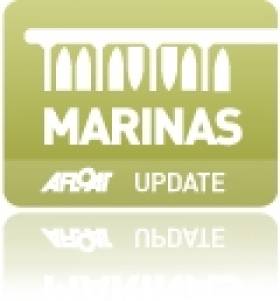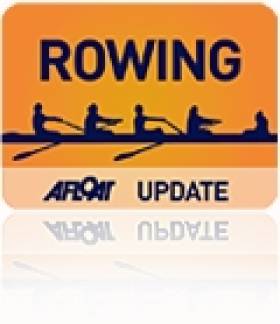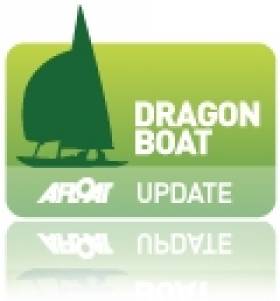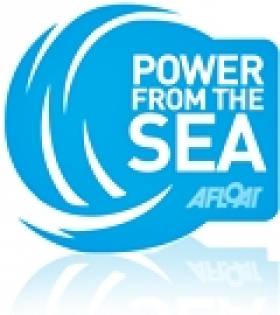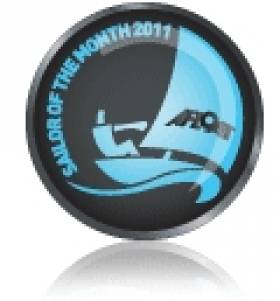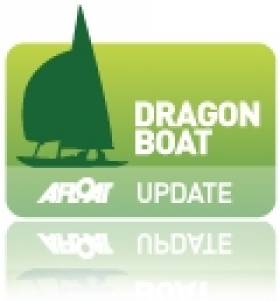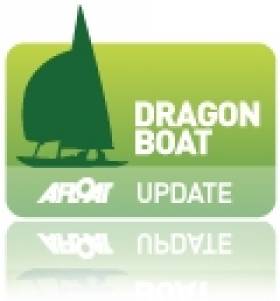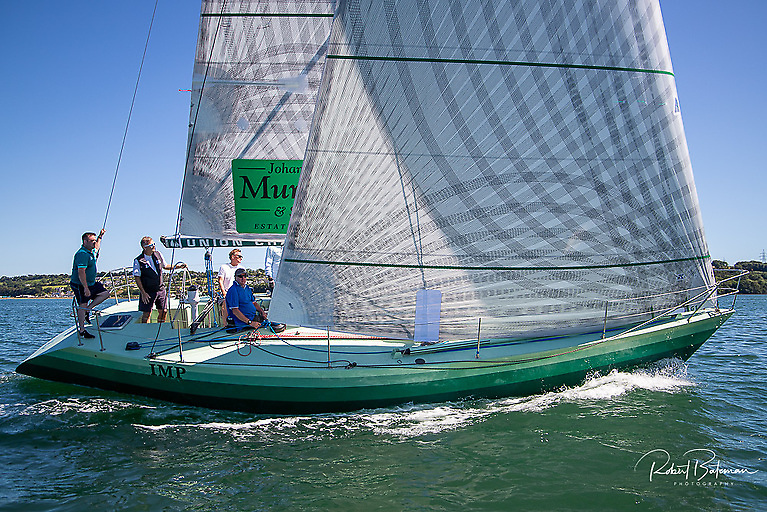Displaying items by tag: Edinburgh
Julia Bailey Wins 2015 Dragon Scottish Championship
#dragon – Twenty of the top International Dragon crews are gathered in Largs for the 2015 Scottish Mortgage Investment Trust Dragon Scottish Championship and Edinburgh Cup. The regattas, which take place from 27 June to 3 July, have attracted competitors from across the UK and as far afield as Japan.
After three days and five thrilling races the Scottish Mortgage Investment Trust Dragon Scottish Championship concluded on Monday evening with the trophy being awarded to Julia Bailey, Keith Tippell, Will Heritage and Pedro Andrade sailing GBR720 Aimee. Team Aimee arrived in Largs as the defending Edinburgh Cup Champions having won both the overall and Corinthian Edinburgh Cup Trophies in Lymington in 2014 with Julia's husband Graham at the helm. Graham was unable to attend this year's regatta so it was Julia's turn to take the helm and she roped in old friend Pedro to complete their team.
From the opening race Cowes based Julia put her stamp on the regatta showing impressive boat speed and tactical superiority. She won three out of the five races and finished third in another with the only blot on her copybook being an OCS disqualification in race two, when she failed to realise she was on the wrong side of the start line.
Julia's nearest rival was Martin Payne from Cornwall, sailing GBR789 Bear with crew Gillian Hamilton and Donal Small, whose constantly improving scoreline of 4, 2, 2, 1 left them three points behind Julia, but clearly still in firm contention for the coming Edinburgh Cup.
Third place overall and the Corinthian Scottish Championship Trophy, for all amateur crews, was awarded to Patrick Gifford of Angus sailing GBR515 Basilisk with his son Michael and guest crew Martin Spall. Patrick was understandably happy with their achievement as their boat is 29 years young and this was the first time they had raced with Martin in the boat.
For Julia her victory was particularly sweet as she noted, "My Grandfather Machlachlan would have been very proud to know that his granddaughter had won the Dragon Scottish Championship." At the prize giving she also paid tribute to the excellent race management provided by the Scottish Sailing Institute's Race Committee headed by Race Officer Chris Hadden, the outstanding quality of the Clyde's sailing waters and the warm Scottish hospitality that has been extended to the competitors since they arrived at Largs Sailing Club.
On Tuesday morning the fleet will begin racing for the Edinburgh Cup, which was presented to the class by HRH The Duke of Edinburgh in 1949 and is awarded annually to the British Open Dragon Champion. Racing will continue until Friday 3 July with up to six championship races plus a crew's race scheduled.
Joining the fleet for this second part of the competition will be a number of top crews including Gavia Wilkinson-Cox sailing GBR761 Jerboa with Mark Hart and Philip Catmur; Tom Vernon sailing GBR795 Excite with Adam Bowers and Oliver Spensley-Corfield; Mike Budd sailing GBR793 Harry with Mark Greaves and Sam Gardiner; and Ron James sailing GBR633 Fei-Lin's Flirtation with Julia Walsh and Mark Pettit.
The Edinburgh Cup is one of sailing's most prestigious trophies and with four days of top level racing ahead of us it promises to be an extremely close competition. Regular updates, results, photos and videos will be posted to the British Dragon Association Blog and via the British Dragons at Facebook.
Edinburgh Marina Set to Lead Scottish Marine Tourism Growth
#marinas – Edinburgh Marina - the 400 berth marina, residential, retail and spa hotel development that will be the focal point of Granton Harbour's regeneration, is set to be at the forefront of Scottish Marine Tourism's strategic growth, as announced by the British Marine Federation Scotland (BMFS).
The new strategy, announced last week by BMF Scotland at a Glasgow event chaired by MSP Stuart McMillan, aims to grow the total value of Scottish marine tourism by 25%, from £360m to £450m, by 2020.
Just 2.5 miles from Edinburgh City Centre, Edinburgh Marina will accommodate in excess of 320 moorings for boats of all types and sizes.
Kevin Fawcett of Granton Central Developments Limited said: "This is excellent news for Scotland and Edinburgh Marina's key location will make it a vital part of BMFS' strategy – it is in pole position to help grow Scottish Marine Tourism. Edinburgh Marina will be a world-class destination for boating enthusiasts from all over the world. The marina is long overdue for Scotland's capital city – especially a city with such rich marine heritage."
The marina facilities have been designed to put Edinburgh firmly on the charts as a marine destination, whilst creating over 700 new jobs and injecting a £30m boost to the local economy each year - over half of which is projected to come from marine related tourism.
The Edinburgh Marina master plan includes local shopping and leisure facilities, a best of Scotland indoor produce market and a hotel, restaurant & health spa - all essential ingredients in successfully growing Scottish marine tourism in line with the strategy announced by BMF Scotland.
Edinburgh Marina: Fact Box
Spa Hotel: 123 beds
Residential: 1,881 units
Retail: 9220 square metres
Leisure: 4220 square metres
Commercial: 5000 square metres
Marina: 400 berths
Distance from Edinburgh City Centre: 2.5 miles
Developer: Granton Central Developments Limited
Architect: Wilson Gunn Architects, Glasgow
Planning Consultant: Paton Planning & Development
Marine Consultant: MDL Marinas
Website: edinburgh-marina.co.uk
Trinity Fall to Edinburgh at Henley Rowing Regatta
#ROWING: Edinburgh University beat Trinity College in the first round of the Temple Challenge Cup at Henley Royal Regatta today. The Scottish crew, managed to gain a lead and hold on to it. Trinity came back strongly at the finish but could not head their rivals. Brown University of the United States will be Edinburgh’s opponents tomorrow.
Henley Royal Regatta, Day One (Irish interest)
Temple Challenge Cup (Men’s Student Eight): Edinburgh University beat Trinity College, Dublin by a canvas, 6 mins 42 seconds.
Dubliner Byrne Leads Denmark's Prince Henrik at Régates Royales
Dragon Edinburgh Cup winner Martin Byrne's impressive international form continues this week at the helm of Jaguar. The Dublin sailor leads HRH Prince Henrik of Denmark for overall honours at the Régates Royales in Cannes, on the south of France. Byrne, the Commodore of Dun Laoghaire's Royal St. George Yacht Club is counting a 1, 1 and 3 in the 58-boat fleet. 'We're off to a good start' Byrne, the Irish Dragon national champion, told Afloat.ie this morning. July's Edinburgh Cup winner is sailing with Brian Mathews and Portuguese sail maker Andrade Pedro.
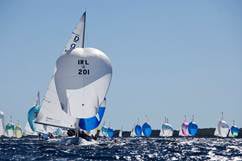
Martin Byrne leads the 58-boat fleet
After the fleet could not go out on the water on Monday because of the strong, gusty typical Mistral breeze, the 58 boat strong Dragon fleet had three windward/leeward races on Tuesday starting in a 12 knots south-westerly, that progressively increased during the afternoon hours, topping 20 knots. Competition was strong as usual for the top positions and the class' champions imposed their supremacy. The first two races went both to Dublin's Byrne on Jaguar Bear who managed to get the better of reigning champion and class master Anatoly Longinov on Annapurna and on multiple class winner Danish Poul Richard on Antigua's flagged Danish Blue on the first one. A nearly clean score for the Irish skipper who was third in the last race of the day won by Ian Bradbury on Blue Haze. HRH Prince Heinrik of Denmark's had a very positive first day with a sixth, a second and a fourth. With five points, the Irish team is then securely on top of the provisional podium, in front of HRH Prince Henrik of Denmark (13 points) and the Russian crew skippered by Anatoly Loginov (16 points).
Plan to Power Edinburgh with Giant Windfarm
Plans are afoot to power Edinburgh with a giant offshore windfarm, the Edinburgh Evening News reports.
The £1.2 billion (€ 1.37 billion) project proposed by Irish group Mainstream Renewable Power could see as many as 130 turbines generate power for up to 335,000 homes.
The turbines would be installed 30km north of Dunbar, East Lothian, though a number would be visible from the coastline.
Concerns have been raised by East Lothian residents at a consultation hearing regarding the environmental impact of the project, dubbed Neart na Gaoithe (might of the wind), though wildlife and environmental surveys are still being carried out.
Any final go-ahead on the windfarm scheme would have to be given by the Scottish government.
As previously reported on Afloat.ie, Mainstream Renewable Power - headed by Eddie O'Connor - has signed deals for windfarms in South Africa and Alberta province in Canada.
The Evening News has more on the story HERE.
Byrne Named July's Sailor of the Month
In a fleet of 44, including many of the world's top boats, he had already put together a solid series as the final day arrived in the excellent sailing waters off Abersoch in North Wales.
But whether or not he and his crew of Adam Winkelmann and Pedro Andrade came home with bronze, silver or gold, hinged entirely on that last race.
Sailing the immaculate Jaguar, he logged the kind of race that, for most skippers, is the stuff of dreams.
Jaguar emerged clear from the starting melee to such good effect that by mid-race she had a clear lead of 200 metres, a comfortable gap that enabled Byrne to keep effective cover on any challengers, such that the real race was for second place as Jaguar powered on to finish an extraordinary three minutes ahead.
It was textbook stuff. In his winner's speech, Martin Byrne said the secret of it all was the shoreside commander, his wife Triona, who looked after logistics and paperwork, and ensured everything ran smoothly all week.
Irish sailing needs more Trionas.
The Byrne win gives a boost towards 2012, which in Ireland will be the Year of the Dragon. The Edinburgh Cup will be on Belfast Lough from July 4-8, while the historic Gold Cup is in Kinsale from September 8-14.
Ireland has won a dozen Edinburgh Cups, the most prolific victor being Tony O'Gorman who won six times between 1975 and 1984.
But only once has the Gold Cup been brought home, in 1947, when it was won by Eric Strain of Belfast Lough. Robin Hennessy was in the frame in 1971 but didn't quite clinch it, so an Irish win is overdue.
And, with the Gold Cup scheduled for Ostende in September, maybe we won't have to wait until next year.
Racing Round up: Dragons, British IRCs, Flying Fifteens, WIORA, ISA Youths, Fastnet and Bay racers
Royal St. George Trio Win Dragon Edinburgh Cup
Royal St. George Commodore Martin Byrne lifted the Dragon Edinburgh Cup in Abersoch, North Wales tonight after a three way last battle for victory went the Dun Laoghaire crew's way in emphatic style.
The current Irish champions won the pivotal final race by over three minutes in breezes touching 25-knots to become the latest holder of the Edinburgh Cup; the British National Championship.
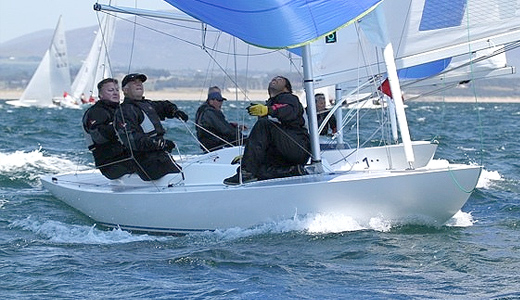
Martin Byrne steers to victory with crew Adam Winkelmann on spinnaker and Pedro Andrade. Photo: Fiona Brown
Celebrations will continue back in Dun Laoghaire tomorrow as the Dragon helmsman and his crew Adam Winkelmann and Portuguese sailmaker Pedro Andrade mark the significant victory that is a major shot in the arm for Irish Dragon sailing.
The 62-year old trophy is one of the most prestigious in the class along with the Gold Cup of this former Olympic keelboat. The 2012 Gold Cup is slated for Kinsale Yacht Club next year so the weekend win is a another fillip for the class here.
It all went down to the wire for the 43-strong fleet from Japan, Australia, Russia, Ireland and the UK on the final day of the 2011 Dragon Edinburgh Cup, supported by Aberdeen Asset Management, at the South Caernarvonshire Yacht Club in Abersoch. Going into the day Mikhail Muratov and Klaus Diederichs sailing with Irish Star keelboat pair Peter O'Leary and David Burrows were tied for the lead on 16 points, Martin Byrne was on 17 points, Julia Bailey counted 23 and Olga White 28. In the Corinthian fleet Richard Goodbody led Simon Brien by a single point with Patrick Gifford and Nigel Biggs both five points behind them.
There were four attempts at getting the final race, the sixth in the series, started including three under black flag. A total of six teams were disqualified including Olga White, whose hopes of making the podium were immediately dashed. Eventually at the fourth time of asking the fleet got away cleanly for what proved to be the best race of the series with the wind up at around 20 knots from the southwest and some nice big waves which made the runs pretty exciting.
Off the line Byrne got the best start at the committee boat end and was the first to tack off to the right with Diederichs and Muratov following. By the mid point Byrne had already established a lead with Diederichs and Muratov jostling for position on the front edge of the pack. Muratov went further right than Diederichs gaining a significant advantage at the top end of the course and as they rounded the first mark Byrne led with Muratov in fourth and Diederichs seventh.
As Diederichs and Muratove fought their way out of the pack, Byrne established control of the race and clearly had no intention of relinquishing it, gradually stretching away from the fleet. Behind him at the leeward mark Muratov rounded third with Diederichs on his tail in fourth.
On the second beat Byrne extended his lead to some 200 yards, Muratov moved into second and Diederichs third. They held their positions on the second run and up the final beat Byrne was able to maintain a loose cover on the fleet and cruise to a very well deserved victory. As Byrne was enjoying himself out front Muratov and Diederichs were still fighting it out. Meanwhile Simon Brien had been showing bursts of incredible speed to pull up through the fleet and as the fleet came on to the final beat he was challenging Muratov and Diederichs. Brien chose to work the middle whilst the other two went hard right and his move paid off. On the line Byrne and his team looked back to see Muratov finish second, Brien third and Diederichs fourth. Brien's nearest Corinthian challengers Nigel Biggs and Patrick Gifford crossed the line in fifth and thirteenth places.
Irish crews are to the fore - inlcuding a new crew combination at the Dragon Edinburgh cup – the British national championships – in Abersoch this week. Irish National champion (and Royal St.George YC Commodore) Martin Byrne lies second overall sailing with last week's VDLR regatta chief Adam Winkelmann. One point behind Byrne is the defending Edinburgh Cup Champion Klaus Diederichs, who this week is sailing with a brand new crew of Olympic Star keelboat pairing, Peter O'Leary and David Burrows.
Unexpectedly good sailing weather and two hotly contested races opened the 2011 Cup, supported by Aberdeen Asset Management, in Abersoch yesterday. The forecast had been for beautiful sunshine but very light airs and the 43 crews from Australia, Japan, Russia, Ireland and the UK went afloat in a fickle 2-3 knot breeze with little expectation of good racing. It took several hours to happen, but fortunately the weather gods eventually smiled on the fleet and at around 2pm the wind began to fill in from the north, quickly building to 16-18 knots and more.
Two cut and thrust races were completed in the sparkling conditions and by the end of the day Russia's Mikhail Muratov, sailing Murka 8 with Valentin Uvarkin and Vladimir Krutskikh had taken the overall lead with a second place in the opening race and a win in race two. Muratov's nearest rival tonight is current Irish National Champion Martin Byrne, racing Jaguar with Adam Winkleman and Pedro Andrade, who won the opening race and went on to finish sixth in race two. Just one point behind Byrne in third overall is defending Edinburgh Cup Champion Klaus Diederichs, who this week is sailing with a brand new crew of Peter O'Leary and Dave Burrows, better known as one of the top Olympic Star teams having finished second at this year's Baccardi Cup. Fourth place overall is currently a tie between Russia's Olga White sailing Murka 7 with Martin Leifelt and Vadim Statsenko, and Gavia Wilkinson-Cox of Cowes sailing Jerboa with Martin Payne and Lars Wegener.
In the Corinthian Division, for which only non-professional crews compete, Burnham's Mark and Mandy Wade racing Avalanche with Andrew Norden lead the fleet and also hold sixth place in the overall standings. Three points behind the Wades is Simon Brien aboard Kin from Cultra, Northern Ireland, sailing with his brother Mark and David Gomes, who also make the overall top ten at eighth place. Just three points separate places three to five in the Corinthian division, which are held by Ireland's Richard Goodbody sailing Diva, Rob Campbell from Burnham sailing Ganador and Owen Pay from Cowes sailing Nijord.
It was a good day all round for the Corinthian teams who certainly gave the pros plenty to think about. The prize for best performance in a single race by a Corinthian boat undoubtedly goes to Owen Pay and his crew of Jon Mortimer and Steve Richardson for their impressive third place in race two. They got a cracking start and put together a controlled first beat to round the weather mark in third place hot on the heels of Julia Bailey and Mikhail Muratov. Despite being under constant attack from both Klaus Diederichs and Martin Byrne, Pay and his team kept their heads and not only successfully defended their position all the way to the finish but at times also put significant pressure on the leading pair.
The Dragon is very much an equal opportunities class and not only are female helms no longer a novelty, but they are now regularly beating the boys at their own game at international level. In race two Julia Bailey of Cowes sailing Aimee with husband Graham Bailey and David Heritage came off the line like a scalded cat and sailed a near perfect beat to round the weather mark in first place neck and neck with Mikhail Muratov. From here on in a dogfight of epic proportions developed with neither boat giving an inch. The two boats rounded every mark neck and neck and were almost constantly overlapped. Bailey threw everything but the kitchen sink at Muratov on the final beat, but she also had to work extremely hard to keep the chasing Owen Pay at bay. The boats traded tacks all the way into the finish but whilst she held off Pay it enabled Muratov to take victory on the line. A slightly disappointing eighteenth place in race one means that Bailey now lies in seventh place overall and she is joined in the top ten by two more top female helms, Olga White and Gavia Wilkinson-Cox, who share equal points after the opening day and find themselves battling it out for fourth place overall.
Abersoch and the South Caernarvonshire Yacht Club are proving to be most enthusiastic and generous hosts for this event and many of the competitors have remarked that whilst the racing is as cut and thrust as any on offer, the atmosphere surrounding the regatta is wonderfully relaxed and harks back to a bygone era. Perhaps it's because the boats are on swinging moorings and the crews are ferried out and back by club launches, perhaps it's the impressive way in which the club members and the local Abersoch Dragon Fleet have clearly pulled together to run the event on an entirely voluntary basis, perhaps it's the incredible hospitality and helpfulness being shown to all competitors, or perhaps it's just that there is something a little bit magical about Abersoch with its majestic mountain backdrop, sandy beaches and unique micro-climate, but what ever it is the Dragon fleet like it and want more please!
And more they can have as racing continues until Saturday 16 July with up to five more races scheduled. The forecast for the coming three days is for moderate to strong winds. Two races are scheduled for Thursday and Friday and a single race is scheduled for Saturday.
Additonal reporting from the Int. Dragon Class


























